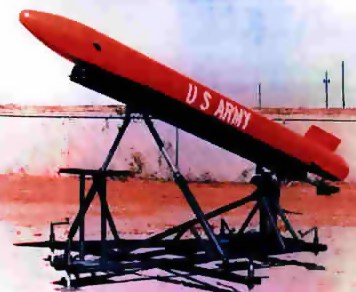USAMICOM MTR-15 BATS
The BATS (Ballistic Aerial Target System), originally known as SPT-B (Selectable Performance Target - Ballistic), is a low-cost system for troop training with low- and medium-altitude air-defense systems. It was developed by the U.S. Army Missile Command (USAMICOM) in the early 1970s, and became operational in January 1972. At that time, it was used for training with the XM163/XM167 Vulcan (20 mm six-barrel gun system), MIM-72 Chaparral, and FIM-43 Redeye air-defense systems.
 |
| Photo: U.S. Army |
| MTR-15A |
The BATS system consists of the MTR-15A target rocket, the launcher, and a fire-control unit. The MTR-15A is an all-metal rocket powered by two to five 70 mm (2.75 in) LSFFAR (Low-Spin Folding-Fin Aircraft Rockets) for boost, and an optional sustainer motor made up of two MXU-4A/A jet engine starter cartridges. In flight, the rocket is stabilized by spin induced by canted fins and motor nozzles. It is launched from a small rail-launcher trainable +/- 9° in azimuth and from 0 to 45° in elevation. By selecting a varying number of booster rockets, changing the launch elevation, and selecting from three different-thrust sustainer nozzle configurations, many different flight profiles can be selected at the launch site. The "pop-up" characteristic of the BATS flight path simulates the trajectory of a high performance threat aircraft which flies low to minimize radar detection, pops up, and then dives on the target to deliver its ordnance.
 |
| Drawing: via Jane's |
| MTR-15A |
At least 11000 MTR-15A rockets have been built, and BATS is currently used to provide training for the short-range air-defense systems Avenger, BSFV (Bradley Stinger Fighting Vehicle) and Stinger-MANPADS (Man-Portable Air Defense System), all using the FIM-92 Stinger surface-to-air missile. BATS is not suitable for training with current gun systems or the ATAS (Air-to-Air Stinger) missile. The U.S. Army originally planned to phase out the BATS by the end of 2000, but this has been postponed, and the Army was still purchasing new-built BATS targets from the industry in 2003.
Specifications
Note: Data given by several sources show slight variations. Figures given below may therefore be inaccurate!
Data for MTR-15A:
| Length | 5.18 m (17.0 ft) |
| Finspan | ? |
| Diameter | 38 cm (15 in) |
| Weight | ? |
| Speed | 140-285 m/s (275-500 kts) |
| Ceiling | 2440 m (8000 ft) |
| Range | 3 FFAR, no sustainer: 3320 m (10900 ft) 2 FFAR + sustainer: 4530 m (14850 ft) 3 FFAR + sustainer: 6070 m (19900 ft) 4 FFAR + sustainer: 7130 m (23400 ft) 5 FFAR + sustainer: 7990 m (26200 ft) |
| Flight Time | max. 47 s |
| Propulsion | Booster: 2-5 70 mm (2.75 in) Mk40 FFAR solid-fuel rocket motors Sustainer (optional): Two MXU-4A/A jet starter cartridges |
Main Sources
[1] R.T. Pretty, D.H.R. Archer (eds.): "Jane's Weapon Systems 1972-73", Jane's, 1973
[2] Redstone Arsenal Historical Information Website
Back to Current Designations Of U.S. Unmanned Military Aerospace Vehicles
Back to Directory of U.S. Military Rockets and Missiles
Last Updated: 22 December 2005